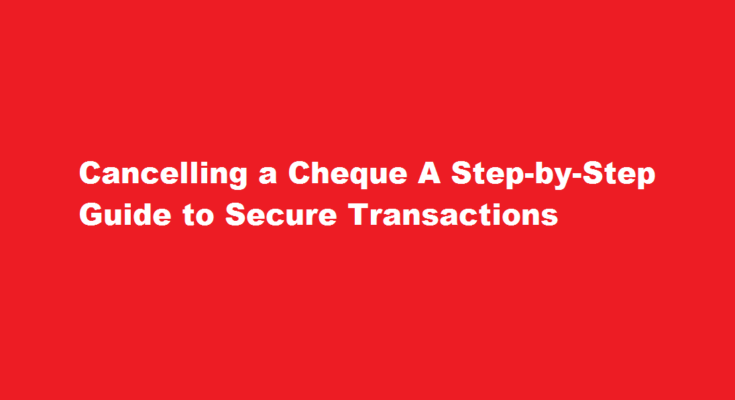Introduction
In the modern world of electronic transactions, cheques remain a reliable and widely used payment method. However, circumstances may arise where you need to cancel a cheque due to errors, loss, or potential fraud. Cancelling a cheque ensures that the funds remain secure and prevents unauthorised parties from cashing it. In this informative guide, we will explore the step-by-step process of cancelling a cheque, empowering you with the knowledge to protect your finances and make informed decisions about your transactions.
Act Swiftly
Time is of the essence when cancelling a cheque. The sooner you take action, the higher the chances of preventing any unauthorised or unintended transactions. If you suspect that your cheque has been misplaced or compromised, don’t delay – start the cancellation process immediately.
Check for Alternatives
Before cancelling the cheque, consider whether an alternative solution might be more appropriate. If the cheque has not been cashed yet, you could approach the payee and explain the situation. They might be willing to return the cheque or void it in your presence.
Gather Information
To cancel a cheque, you will need specific details about the transaction. Collect essential information such as the cheque number, date of issue, payee’s name, and the exact amount written on the cheque. This information will help your bank to identify the specific cheque and process the cancellation more efficiently.
Inform Your Bank
Contact your bank as soon as possible to initiate the cancellation process. You can either visit the branch in person or get in touch with the bank’s customer service through phone, email, or online chat. Inform them about the situation and provide all the necessary details about the cheque you want to cancel.
The Stop Payment Order
Once you have informed your bank, they will execute a “Stop Payment Order” on the cheque. This action prevents the bank from processing the cheque if it is presented for payment in the future. Be prepared to pay a fee for this service, as most banks charge a nominal amount for issuing stop payment orders.
Written Confirmation
To ensure proper documentation and avoid any disputes in the future, request written confirmation of the stop payment order from your bank. This confirmation should include details like the cheque number, date, and the payee’s name. Keep this confirmation safe for your records.
Monitor Your Account
After cancelling the cheque, it’s crucial to monitor your bank account closely. Keep an eye on all transactions to ensure that the cheque is not mistakenly processed. If you notice any irregularities, notify your bank immediately.
Issue a Replacement Cheque
If the cancelled cheque was intended for a legitimate payment, issue a replacement cheque to the payee as soon as possible. This proactive step will help maintain a healthy business or personal relationship and ensure the transaction is completed on time.
Destroy the Cancelled Cheque
Once you have confirmation that the cheque is cancelled and no longer valid, destroy the cheque properly. Shred or tear it into tiny pieces to prevent any potential misuse or identity theft.
Learn from the Experience
Use the incident as a learning opportunity. Reflect on what led to the need for cancellation and take preventive measures to avoid similar situations in the future. Consider using electronic payment methods or online banking for added security and convenience.
Frequently Asked Questions
Do we need to mention the date on the cancelled cheque?
You need to strike off the cheque by drawing two parallel lines across it and mention CANCELLED between them. 2. Do not sign the cheque or mention date or write anything else on the cheque leaf.
How many times can we use a Cancelled cheque?
As the name suggests, a cancelled cheque is one that is crossed and the term “Cancelled” is written on it. Except this, nothing else needs to be written on the cheque. By manually crossing the cheque and writing cancelled on it, the cheque can never be misused.
Conclusion
Cancelling a cheque may seem like a daunting task, but with the right knowledge and prompt action, it can be a straightforward process. By acting swiftly, informing your bank, and following these steps diligently, you can protect your financial interests and maintain control over your transactions. Remember, staying vigilant and being proactive are essential when it comes to safeguarding your financial assets in the digital age.
Read Also : Unveiling The Irrationality of √5: A Mathematical Journey



